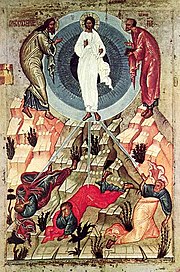
The Jesus Prayer, also known as The Prayer, is a short formulaic prayer, esteemed and advocated especially in Eastern Christianity and Roman Catholicism:
Lord Jesus Christ, Son of God, have mercy on me, a sinner.
The universal call to holiness is a teaching of the Roman Catholic Church that all people are called to be holy, and is based on Matthew 5:48: "Be you therefore perfect, as also your heavenly Father is perfect". In the first book of the Bible, the call to holiness is expressed in the Lord's words to Abraham: "Walk before me, and be blameless".

Christian meditation is a form of prayer in which a structured attempt is made to become aware of and reflect upon the revelations of God. The word meditation comes from the Latin word meditārī, which has a range of meanings including to reflect on, to study, and to practice. Christian meditation is the process of deliberately focusing on specific thoughts and reflecting on their meaning in the context of the love of God.
Opus Dei and Catholic Church Leaders discusses the comments and observations of popes, cardinals, and other leaders of the Catholic Church as regards the Personal Prelature of the Holy Cross and Opus Dei.
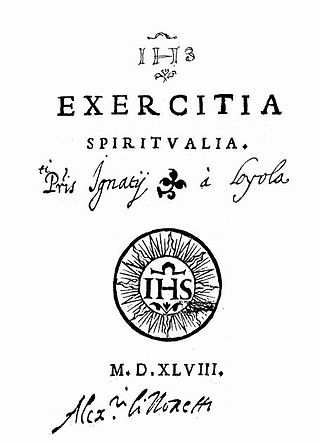
The Spiritual Exercises, composed 1522–1524, are a set of Christian meditations, contemplations, and prayers written by Ignatius of Loyola, a 16th-century Spanish priest, theologian, and founder of the Society of Jesus (Jesuits). Divided into four thematic "weeks" of variable length, they are designed to be carried out over a period of 28 to 30 days. They were composed with the intention of helping participants in religious retreats to discern the will of God in their lives, leading to a personal commitment to follow Jesus whatever the cost. Their underlying theology has been found agreeable to other Christian denominations who make use of them and also for addressing problems facing society in the 21st century.

Teachings of Opus Dei are the teachings of the founder of Opus Dei, St. Josemaría Escrivá de Balaguer.
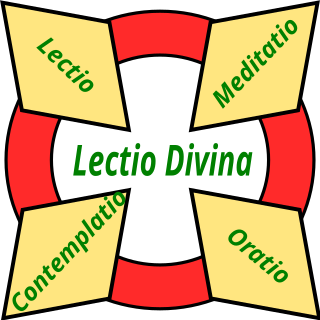
In Western Christianity, Lectio Divina is a traditional monastic practice of scriptural reading, meditation and prayer intended to promote communion with God and to increase the knowledge of God's word. In the view of one commentator, it does not treat Scripture as texts to be studied, but as the living word.
Opus Dei is a personal prelature within the Roman Church that has been the subject of numerous controversies. Throughout its history, Opus Dei has been criticized by many, including by numerary members who knew the founder and had roles in Opus Dei's internal government. The reports by former members in the US, England, Spain, Latin America, France, Germany, and other countries are published. Journalists have described it as "the most controversial force in the Catholic Church" and its founder Josemaría Escrivá as a "polarizing" figure.

The Sodality of Our Lady, also known as the Sodality of the Blessed Virgin Mary, is a Roman Catholic Marian society founded in 1563 by young Belgian Jesuit Jean Leunis at the Roman College of the Society of Jesus. The modern Ignatian lay group Christian Life Community traces its origins to the first Sodality.
The Christian Life Community (CLC) is an international association of lay Christians who have adopted an Ignatian model of spiritual life. The Community is present in almost 60 countries.

The Carmelite Monks or Monks of the Most Blessed Virgin Mary of Mount Carmel are a public association within the Diocese of Cheyenne, dedicated to a humble life of prayer. The Wyoming Carmelites claim loyalty to the Magisterium of the Catholic Church and to the Carmelite charism. Their life includes strict separation from the world and the living of the cloistered Carmelite spirituality and way of life established by John of the Cross and Teresa of Jesus. In accord with the Carmelite Rule, they engage in manual labor and the study of Carmelite spirituality in the solitude of the mountains, with the firm hope of attaining to Union with God.

Mental prayer is a form of meditational prayer, "performed without aid of any particular formula." It is distinguished from vocal prayers, "prayers performed by means of a given formula." The aim of mental prayer is 'to inflame souls with the love of God' and 'live without sin'. In mystical practice, it is to be followed-up by contemplative prayer.

Prayer in the Catholic Church is "the raising of one's mind and heart to God or the requesting of good things from God." It is an act of the moral virtue of religion, which Catholic theologians identify as a part of the cardinal virtue of justice.
The Secular Order of Discalced Carmelites, formerly the Secular Order of Discalced Carmelites of the Blessed Virgin Mary of Mount Carmel and of the Holy Mother Saint Teresa of Jesus, is a third order of Catholic lay persons and secular clergy associated with the Discalced Carmelites.
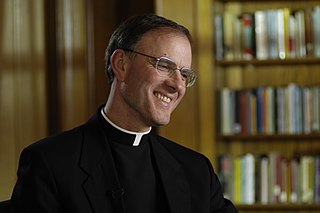
Timothy M. GallagherOVM is an American Roman Catholic priest and the Denver-based author of many bestselling books on the theology and spirituality of Ignatius of Loyola, and other themes of the spiritual life. He served for twelve years in formation of seminarians, for ten years as provincial superior of his Catholic religious congregation, the Oblates of the Virgin Mary, and since 2000, has been dedicated to a ministry of writing, public speaking, retreats, digital events, and spiritual direction.

Christian prayer is an important activity in Christianity, and there are several different forms used for this practice.
A religious brother is a member of a religious institute or religious order who commits himself to following Christ in consecrated life of the Church, usually by the vows of poverty, chastity and obedience. He is usually a layman and usually lives in a religious community and works in a ministry appropriate to his capabilities.
Ignatian spirituality, similar in most aspects to, but distinct from Jesuit spirituality, is a Catholic spirituality founded on the experiences of the 16th-century Spanish Saint Ignatius of Loyola, founder of the Jesuit order. The main idea of this form of spirituality comes from Ignatius's Spiritual Exercises, the aim of which is to help one "conquer oneself and to regulate one's life in such a way that no decision is made under the influence of any inordinate attachment." The Exercises are intended to give the person undertaking them a greater degree of freedom from his or her own likes and dislikes, so that their choices are based solely on what they discern God's will is for them. Even in the composition of the exercises by Ignatius early in his career, one might find the apostolic thrust of his spirituality in his contemplation on "The Call of the Earthly King" and in his final contemplation with its focus on finding God in all things.
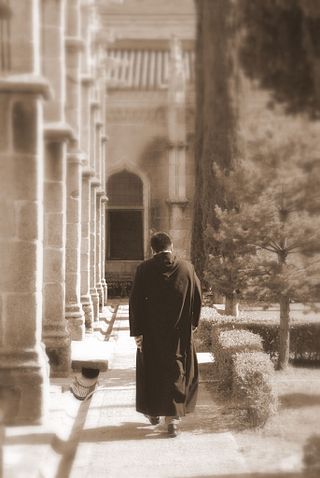
Prayer has been an essential part of Christianity since its earliest days. As the Middle Ages began, the monastic traditions of both Western and Eastern Christianity moved beyond vocal prayer to Christian meditation. These progressions resulted in two distinct and different meditative practices: Lectio Divina in the West and hesychasm in the East. Hesychasm involves the repetition of the Jesus Prayer, but Lectio Divina uses different Scripture passages at different times and although a passage may be repeated a few times, Lectio Divina is not repetitive in nature.
The Servants of Christ Jesus is a Catholic private association of the faithful in the Ignatian and Franciscan traditions, following the formula of the Institute of Saint Ignatius of Loyola and based in Denver, Colorado.
